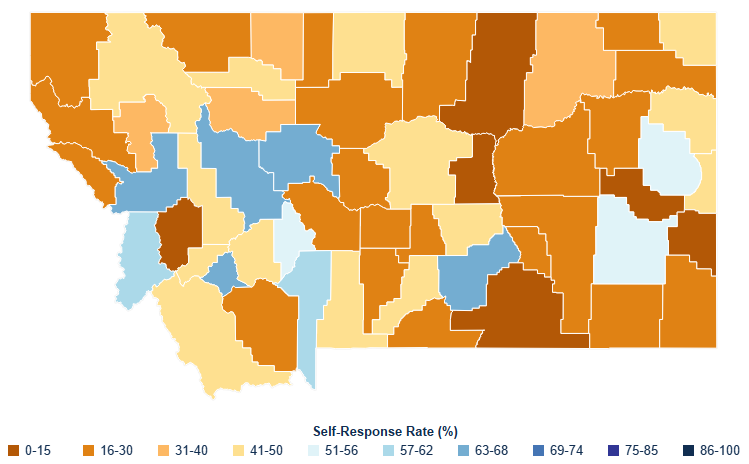Montana Free Press
HELENA — Members of the commission tasked with redrawing Montana’s legislative boundaries following the 2020 census expressed frustration over the state’s dragging response rate in Native communities and other rural areas June 10, citing complications from the COVID-19 pandemic that have disrupted get-out-the-count efforts.
One, Republican Jeff Essmann of Billings, worried a low count could cost Montana its opportunity to gain back a second seat in the U.S. House.
“If we don’t have these rural counties and our Native populations properly counted, we’re not going to be getting that second congressman,” he said.
“I’m fearful that we’re setting ourselves up for a major undercount both in our rural counties as well as our reservation counties at this point,” said fellow redistricting commissioner Joe Lamson, of Helena.
Response rates are even lower in some rural American Indian communities. In census tracts on the Blackfeet Indian Reservation in north-central Montana, 7.3% of households had responded to the count. On the Northern Cheyenne Indian Reservation in southeast Montana, the response rate was only 3.6%. In Helena’s Lewis and Clark County, in comparison, 64.6% of households had filled out their census form as of the same date. In Missoula County, the figure is 64.3%. The challenge, Craigle said, is that, unlike urban residents, many rural residents haven’t had the Census Bureau mail forms directly to their dwellings. That’s because the national population count is conducted by trying to reach people at their physical residences, meaning the Census Bureau doesn’t mail forms to the post office boxes used by many rural residents. Instead, census officials had planned to have workers drop off packets directly at about 120,000 rural Montana dwellings. Those efforts, however, were derailed by the COVID-19 pandemic, which drove the Census Bureau to suspend field operations in April. With the pandemic tide apparently receding, PPE-clad census workers resumed rural packet deliveries in Montana the week of May 4. Even so, more than two months after the heavily marketed April 1 “Census Day,” only 84% of census packets have been delivered, Craigle said Wednesday. Craigle also said she’s been told by census officials that they still haven’t hired enough workers to deliver census packets in some tribal communities and seven rural counties. Those tribal communities are the Fort Belknap, Crow and Northern Cheyenne reservations, and the rural counties are Daniels, Carter, Judith Basin, Powder River, Prairie, Treasure and Valley, she said. “We definitely have a ways to go,” Craigle said. After census organizers encourage as many responses as they can via online and distributed forms, canvassers will be dispatched to knock on doors in an effort to count households that haven’t yet responded. Those efforts had been scheduled to start in May, but are now slated to run from August to October. The Census Bureau has asked Congress to give it a four month extension on a Dec. 31 deadline to deliver initial census results to the president.The system is broken. Let’s build a new one. Start by filling out #Census2020. Representation matters. Fight the undercount of people of color. @AAAJ_AAJC pass it on! #MyFamilyCounts #IndianCountryCounts https://t.co/JZaRGasm5B pic.twitter.com/oItbvCpTqw
— National Congress of American Indians (@NCAI1944) June 8, 2020
Mandated by the U.S. Constitution, the national census is a once-a-decade effort to count every single American, producing the official population statistics that are used to allocate congressional seats among states. Census population data is also used by Montana’s redistricting commission to redraw state legislative districts, and census data also directs how an estimated $2 billion a year in federal funding flows into the state. In Montana, the stakes for the 2020 census are particularly high because estimated population growth since 2010 has the state on the verge of regaining the U.S. House seat it lost following the 1990 census. A 2019 analysis by consulting firm Election Data Services, for example, projected that Montana would add a second seat by a slim margin of just a few thousand counted residents. “Ten years ago we missed getting that seat by a whisper,” Essmann said in an interview. “That chance of that second seat could quite easily slip away, and then it’s another 10 years.”Tribal communities that are working day and night to protect themselves from #COVID19 are facing a new threat: being undercounted by the U.S. Census Bureau. @uscensusbureau #Coronavirus #IndianCountryCounts #Census2020 https://t.co/dZfFo9lbZO
— indianz.com (@indianz) May 27, 2020
Between COVID-19, national debate over police reform and the potential for a pandemic-induced state budget crunch, he and other redistricting commissioners said they were worried census advocates will have a tough time elevating the get-out-the-count message over public attention on other issues. Craigle said she and other state officials have been working on a proposal for getting additional funding for census efforts. “I believe there’s still a chance we can work through this, but it’s a lot harder,” she said. This story is published by Montana Free Press as part of the Long Streets Project. This work is supported in part by a grant from the Greater Montana Foundation, which encourages communication on issues, trends, and values of importance to Montanans. Reach Lead Reporter Eric Dietrich at edietrich@montanafreepress.org.Less than half of Montanans have responded to the Census, putting critical investments into our state on the line. We can do better—fill out your form today: https://t.co/2nJGgtFwL4 https://t.co/Xfl4C4MPZo
— Senator Jon Tester (@SenatorTester) May 1, 2020
Eric Dietrich a journalist and data designer and the founder of the Long Streets economic reporting project. He has worked for the Great Falls Tribune, Bozeman Daily Chronicle, and Solutions Journalism Network. Contact Eric at edietrich@montanafreepress.org and follow him on Twitter @eidietrich.
Note: This story originally appeared on Montana Free Press. It is published under a Creative Commons license.
Join the Conversation

